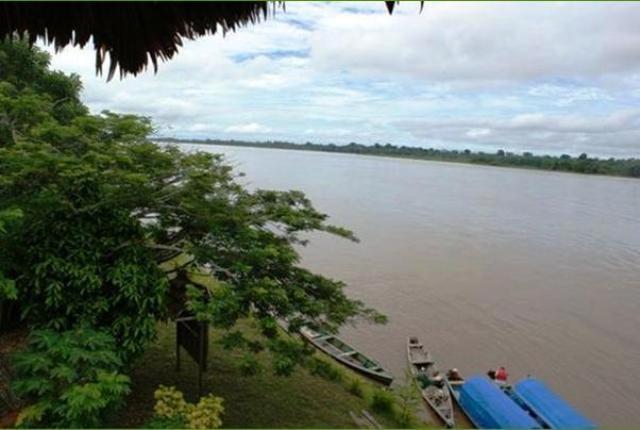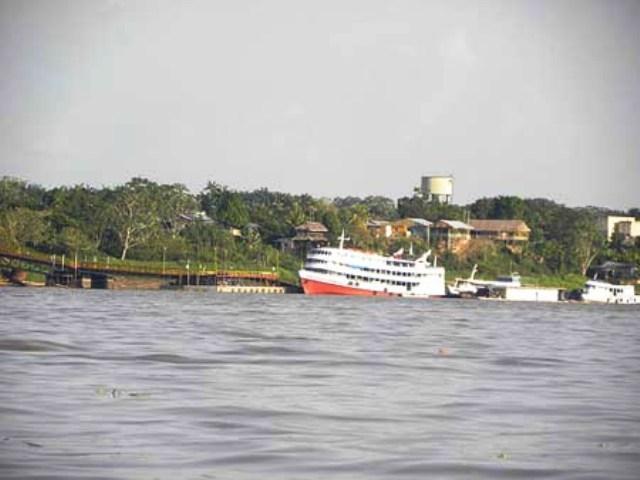Leticia, Amazonas, Colombia
Suggest Place to Visit
727
Track to location with GPS |
 |
Capital of the Amazon, it was founded on April 25, 1867, with the name of San Antonio, when the vast Amazon region lacked a definition of its limits. In 1930 it became the domain of Colombia through the Lozano-Salomón treaty, but the following year the Peruvian government denied the agreement and tried to seize, by force, the Amazonian trapeze and Leticia. The only international war in the country was registered so far this century, so that national sovereignty in such areas and in the southern city was defined.
The current territory of the department of Amazonas was populated in pre-Columbian times by numerous indigenous groups, many of which subsist thanks to the jungle environment; Among them, the most important are the Ticunas, Cubeos and Carijonas. The first conqueror to arrive in these territories was Francisco de Orellana, who in 1524 began a tour of the river that he would later call the ´´Amazonas´´, by the aboriginal warriors who attacked him during the trip.
In the Colony, the entire region north of the Napo and Amazon rivers to the mouth of the Caquetá was part of the province of Popayán. During the period of Gran Colombia (1821-1830), the current territory of the Amazon was part of the departments of Asuay and Boyacá, between 1831 and 1857 it belonged to the national territory of Caquetá, in 1857 it became part of the federal state and then, in 1886 from the department of Cauca.
Upon declaring independence, Peru and Brazil began a policy of colonization and annexation of territories; then, the department of Amazonas was the subject of multiple litigation and border incidents and diplomatic efforts and wars of some seriousness. In 1928 the Amazonas Police Station was created, which in 1931 was converted into the Intendancy and in 1934, the Amazon Special Police Station was created with the capital Leticia. Finally, in 1991 the constitutional reform of 1991 elevated that territory to the category of department.
Leticia is built on the left bank of the Amazon River. Its condition as a border city gives it special characteristics, to which are added those of a river quality that has a special trade. Leticia enjoys intense trade with neighboring countries, especially Brazil. Its communication with the interior of the country is aerial, the city has an adequate official and commercial infrastructure.
Industry and livestock operate under the constraints of the difficult trade in crops and cattle. It is worth noting its growth in recent years, given the potential offered by its territory and the great development achieved by tourism.
Thanks to the possibilities of displacement and the established official point of departure from its riverside capital, it is possible to depart to the National Natural Parks of Amacayacu, Cahuinari and La Paya, apart from magical places such as the so-called Isla de los Micos, famous for its abundance of these; as well as attractive excursions by river, where it is possible to get up close to the famous piranhas and caimans that the guides momentarily catch for tourists to admire.
Amid the silence of the Amazonian nights, the murmur of the river cannot be heard either. Sometimes, however, the body of water is illuminated with distant lightning flashes that reveal the silhouettes of boats and houses belonging to beings from three countries, whose existence takes place in the middle of an unchained river flow.
´´It´s not going to rain, that´s for sure´´, comments spontaneously a woman who seems to understand the matter. Minutes later a downpour breaks out in the Colombian city of Leticia, the water falls incessantly for about 20 hours, but again the Amazon River, immobile, seems not to notice.
Faced with so much humidity, refuge is sought in bars or soda fountains. ´´There used to be a lot of money here from coca, but you could hardly live, ´´ remembers Joel, one of the many guides who are looking for conversation in Leticia. ´L´L boss, we can go out for four, or even 10 days, into the jungle, we are going to see wild animals and indigenous peoples, where nobody goes, ´´ is her offer around beer on a steamy night.
Leticia, which in its most troubled times was a pearl of drug trafficking, is an apparently peaceful town of about 25,000 people located between the jungle and the river. Right there the Amazon has three borders, between Colombia, Peru and Brazil.
In the area there are a few populated centers, although the Colombian Leticia is the most consolidated. Next to it, on the north bank of the river, is the Brazilian Tabatinga, just as large but a little more precarious. On the southern shore, Brazil has Benjamin Constant, and Peru some smaller and poorer towns, such as the ironic Puerto Alegría or the ephemeral Iceland.
The people of these villages practice a dynamic coexistence. Gone is the colonial past, when Spain and Portugal disputed supremacy on the great river. And apparently some later borderline disagreements were also buried.
Now canoes, boats and boats of various sizes communicate all these points by navigating the waters of the Amazon. Those from Leticia like to go to Brazil for caipirinhas, while Brazilians and Peruvians frequent the Colombian city. The residents of each locality, on the other hand, are a mix of the three nationalities, speaking Portuguese and Spanish.
As in the rest of the river, many people live from agriculture and fishing. Strange fruits, or the best known but of unreal size, populate the markets of Leticia or Tabatinga. And there are dozens of varieties of fish, with names that recall the origin of things: pirarucú, tucunaré, jaraquí or tambaquí.
Leticia began as a mission, and later Peru founded a border town there in 1867, but its territory was always claimed by Colombia, a country that took over its sovereignty in 1930. In 1932 the two nations staged border skirmishes that almost ended in formal warfare.
The city was also troubled in the 1970s when it was a center for drug trafficking operations. Silver flowed through the streets, and there was a bonanza throughout the area. But it is remembered that there were murders every day.
That vocation for illegality was diluted during the 1980s. No one doubts that merchandise does pass through the triple border, but not as in the past. ´´It was very hard. Once the police arrived and fired from the planes, then they put 55 kilos of merchandise on my back and gave me the order to escape. If I was carrying the merchandise, they would shoot me, and if not, they would shoot me too, ”a taxi driver recalled.
However, it is obvious that silver is still moving in Leticia, suffice it to say that near the market there are more than 20 small stores dedicated to currency exchange: Colombian pesos, Brazilian cruzeiros, Peruvian nuevos soles, and dollars. Nowhere else on the border is like this, and in Benjamin Constant, across the river, it is almost impossible to trade currency.
An important part of this economic movement comes from activities such as the sale of Amazon River fish, since there are several companies that freeze it and sell it in large quantities to other parts of Colombia and the world. Also from high-priced crops, such as pepper.
Like all places that are debated with reality, Leticia is also full of mythologies, which sometimes really exist. Like the huge house, or the mysterious hacienda, that everyone attributes to a drug dealer. Or like the stories about the gringo who is now in prison, but once had ships that brought a nightclub to town from Miami piece by piece.
They also say that the name was given by an engineer, whose girlfriend was called Leticia Smith. There is also the guide known as Alberto, a modern tarzan who appeared on television when he crossed dozens of kilometers of the river swimming, or the gringos who, according to people, sometimes appear in town and belong to a secret base of the US DEA .
At the zoo, Don Luis struggles to maintain the collection of Amazon animals. Some afternoons he and his helpers use sticks to shove several pounds of meat into a boa too lethargic to feed itself. "If not, he dies," says the park manager.
Volkswagen taxis travel about 2 km from International Avenue to Tabatinga, where there is less asphalt, less light, less water, and poorer. There are also more bars.
Like other Amazonian points, Tabatinga and Benjamin Constant receive immigrants from other poorer areas of Brazil, and that determines their growth. In this case, there is no doubt that the possibility of negotiating with Colombia opened many doors at one time, and continues to offer them. Most of the Brazilian fishermen in this sector of the river, for example, sell their catch in Leticia.
In the three borders of the Amazon, all the towns are different.
NATURAL ATTRACTIONS
AMACAYACU NATURAL NATIONAL PARK
In its 293,000 hectares there are sparse forests in which trees such as mahogany, rubber, balso and other red and white cedars, among others, can exceed 50m. Traditionally it has been inhabited by the Ticunas. They have a visitor center. July is the least rainy month. It is located 3 hours from Leticia and 30 minutes from Puerto Nariño, by river.
CAHUINARI NATIONAL NATURAL PARK
The forest is protected in 575,000 hectares in the basin of the Cahuanarí and Bernardo rivers, on whose beaches live black caimans up to 10 m in length and charapas, the largest freshwater turtles in the world, today in danger of extinction.
ISLAND OF MICOS
Sanctuary of Fauna and flora of the region. It is located in front of the village of Santa Sofía.
LAKE YAHUARCACAS
Beautiful, in its crystalline waters live the pink dolphin, the dolphin and the royal victories. Located on the outskirts of Leticia.
PUERTO NARIÑO
The second most important city in the department, it is inhabited by indigenous Ticunas and Yaguas, as well as settlers and merchants. In its surroundings is Lake Tarapoto, surrounded by huge ficus trees and where you can admire the royal victories and pink dolphins. It is located 72 km, 2 hours from Leticia, upstream by the Amazon River.
LAKES
Beautiful and rich in fauna and flora you can visit those of Zaraica, Terezinha, Laguiño and laguna grande, in Brazil, and that of Moroyoa, in Peru, located near Puerto Nariño.
SAN MARTIN
Ticuna population, in it you can learn about the customs of its inhabitants and buy handicrafts. Located near Puerto Nariño, journey on foot.
GASTRONOMY
Given the abundance of rivers, the preferential consumption of fish is natural, complemented with cassava (made with wild, poisonous cassava), banana and exotic fruits such as arazá, copoazú and Amazonian anón.
MEANS OF TRANSPORT
Aerial:
Airports
Vázquez Cobo Airport: Tel. 592-7192, 592-7238, 592-7353
Comments
We don´t have yet any comments about:
Leticia
Leticia
Be the first to leave a comment as it is very important to inform other people
Outros locais a visitar
Within a radius of 20 km from:Leticia
Amazon river |
| 6,6 Km |
 |
Hotel reservation near Leticia within a radius of 20 km
Why to book with ROTAS TURISTICAS
The best prices
Our partnerships with the world´s largest operators offer research on the best market prices.
More options
At Rotas Turisticos you can book the hotel, buy the air ticket, book the transfer from the airport to the hotel and vice versa, book the local excursions, rent the car, take travel insurance and consult the places to visit and where to go.
Holiday Tips & Destinations
Hundreds of holiday destinations with all the options that allow you to easily choose the destination that best suits your dream vacation.
ROTAS TURISTICAS
Links





